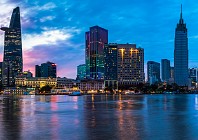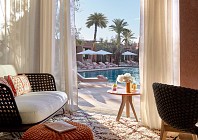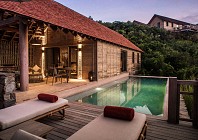The colonial French used to rhapsodise about it as a “balcony on the Pacific,” and its unfettered ocean, uncluttered sands and fresh waters make you feel you have found something the rest of the world has yet to discover.
So if Vietnam doesn’t spring to mind when you dream of golden beaches – not to mention luxury resorts, stunning spas, gourmet dining, and world-class golf – it’s time to think again. And fast.
Virtuoso, one of the world’s premier travel agent networks, recently placed Vietnam in the three top emerging luxury travel destinations in the world, so now is the time to catch it, before the crowds move in.
“Beaches here are less crowded and therefore very clean, and are also recognised for their serene beauty,” says Patrick Basset, Accor’s vice president of operations for Vietnam, the Philippines, Japan and South Korea.
Accor is adding 2,000 additional rooms to the 2,150 it already has in the country through developments like the new 131-room Le Belhamy Hoi An Resort and Spa.
Most of Vietnam’s top beaches and prime resorts start half way down the country at the Danang-Hoi An corridor. China Beach, a 32-kilometre stretch of golden sands made famous 40 years ago as the R&R venue for American troops stationed at the US air force base, runs down to the beguiling riverside UNESCO town of Hoi An, one of the most visited heritage sites.
Billboards for Hyatt Regency, Le Meridien, Raffles, Crowne Plaza and other major brands on cordoned-off plots along the beach announce massive development.
“They will be large resorts and will target the MICE (meetings, incentives, conferences and exhibitions) tourism sector. It will be a challenge to develop these segments and I believe it will take four or five years to be able to bring the business in,” says John Tue Nguyen, founder and CEO of Vietnam-based Trails of Indochina.
Hoi An’s seaside, a comfortable tuk-tuk ride from the old town, offers budget to five-star accommodation, but the top-drawer property in the area is the Nam Hai, a GHM hotel. The hotel’s 60 villas, plus 40 pool villas with walled courtyards and landscaped gardens directly on the golden beach, are the epitome of understated class and luxury.
General manager John Blanco says Vietnam’s beaches range from crystal clear waters to surf-ready breaks. “Pair this with its rich cultural heritage, exceptional cuisine and a gorgeous, genuine service culture and you have Asia’s best-kept secret. And let’s not forget the consistently warm waters as well.”
Golfers are well catered for too, with a plethora of fine courses available throughout the country. The Montgomerie Links, a manicured carpet of emerald turf, is just a championship-shot away from the Nam Hai, and has just rolled out some swanky on-course villas; a first for Vietnam.
If you’re not a golf buff and have done with lazing on the beach, there’s no shortage of things to see and do. Forget sophisticated, flashy attractions; what you will find are heritage towns like Hoi An, imperial cities like Hue, ancient Cham towers, remnants of French colonial grandeur and cheery coastal towns where slower is better.
Take a walk around any local market and you’ll be amazed by the wealth and quality of the produce and captivated by the smiles of the local people.
Nha Trang is Vietnam’s grande dame of beach resorts and, despite its popularity and smart hotels, it has a laid-back air and a buzzing nightlife without the cheap neon and sleaze that is, alas, interwoven into the fabric of so many Asian beach destinations.
Its most eye-catching property, the new Sheraton Nha Trang, is Vietnam’s first international brand property outside the two main cities, and fronts the Forbes-acclaimed Nha Trang beach.
General manager Scott Hodgetts says there are common denominators among Vietnamese beaches. “They all seem to be wide-swathed, appear to lack commercial intrusion, and most evoke a feeling of remoteness,” he explains.
“In Nha Tran, as in Danang, the beaches are also quintessential viewing platforms for the islands that comprise some of this country’s most beautiful offshore formations. I would think that’s worth travelling for.”
The Sheraton’s rooms all have sea views (top marks to the architects) and there is an infinity pool, a custom-built cookery school and a dim sum and noodle shop which premiers the Sheraton’s new Steam n’ Spice restaurant brand.
The rocky coastline south of the town of PhanTiet belies Ka Ge Bay; an undisturbed and picture-perfect arc of white sand backed by a promontory with an old French lighthouse. The town has only two incumbents: a small fishing village and the Princess d’Annam Resort & Spa.
General manager Jean-Philippe Beghin leaves no doubts as to his resort’s appeal: “On Ke Ga Bay we’re the beneficiaries of the most dependably sunny weather in Vietnam. I have guests from Europe and the United States who plant themselves on our beach all day long.”
The Princess d’Annam’s 57 colonial-style villas are set in landscaped grounds, which have to be some of the most beautiful in Vietnam. The custom-built spa, eclectically-stocked wine cellar, and Chef An’s gourmet cuisine are further reasons to forget you have a return air ticket. And the nearby Nick Faldo-designed Ocean Dunes Golf Club is one of Vietnam’s prettiest and toughest golfing venues.
Claudio Kellenberger, general manager of Asian Trails for Vietnam calls Phan Thiet and Hoi An-Danang trendsetters. “They are home to most of our top five-star resorts,” he says.
“However infrastructure outside the luxury properties often remains ‘local’ without upscale gastronomy or nightlife.
Phan Thiet, getting there in time to be awed by the staggering amounts of fish being sorted and packed straight off the trawlers.
We then wandered around the calm gardens of the old school where Ho Chi Minh taught, and stopped on the way back to admire the red sand dunes along the coastal road.
An afternoon stroll along Ke Ga beach brought us to a fishing village, where men were hauling in small teacup-shaped boats and children kicked footballs. On the way back the lights in the dragon fruit plantations sparkled as brightly as the stars shimmering on the calm waters.
Driving down towards Ho Chi Minh City, one area that has come in for low-key development is Mue Ne. This small fishing village has low-rise hotels, open-fronted shops and family-run restaurants, which serve some of the freshest (and best value) seafood in Vietnam.
The Blue Ocean Resort, managed by the Life Resorts Group, is comfortable and friendly, and the long beach is popular with windsurfers and kite boarders.
The island of Phu Cuoc, close to the Cambodian border, is sprucing up now that direct Vietnam Airlines ATR 72s and privately owned Mekong Air’s Canadair CR900 jets make it just a 40-minute hop from Ho Chi Minh international airport.
Kellenberger says it is not yet a mass destination and will remain that way for the next three
or four years, at least until the announced international airport and 9,000 new hotel
rooms take off.
“For now it is a ‘pearl’ with the most beautiful beaches in Vietnam, crystal clear waters, white sand and incredible sunsets,” he explains. “The people are very friendly, open to foreigners and proud to show off their island. There is also very little traffic and it is good value for money.”
Can anyone guess where we’ll be heading on holiday next year?











